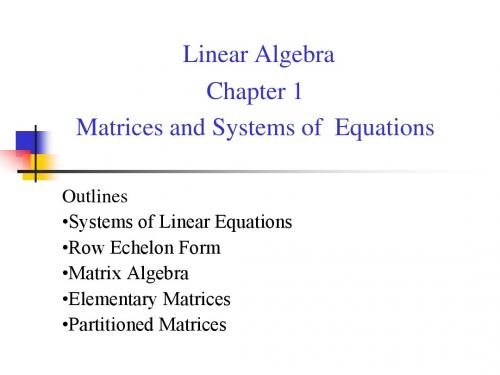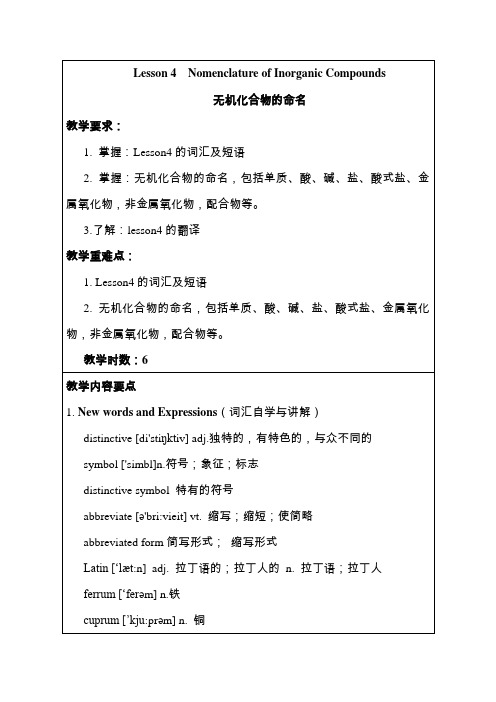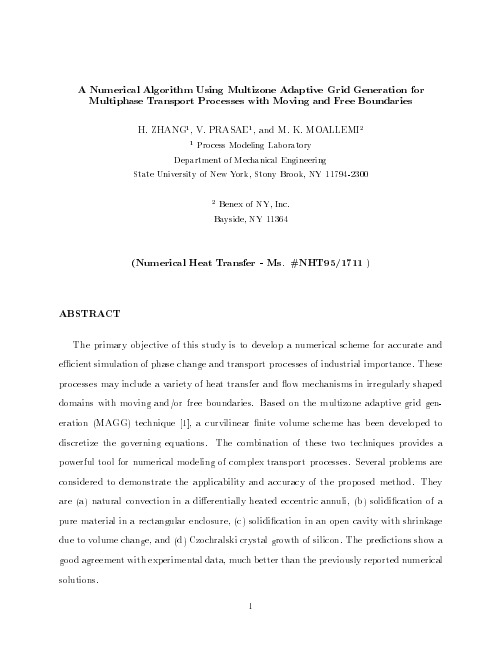Lecture 1-2 The nomenclature of inorganic compounds-2017-2
- 格式:pdf
- 大小:246.00 KB
- 文档页数:26




Reading and Vocabulary外研版Step 1 PresentationThe teachers words: Look at the title . Renaissance usually means a new growth of something , especially art, literature or music. Judging from the title, what do you think Renaissance will refer to in this article? What time, what place and what persons do you guess will be mentioned here?On this basis , finish the activity 1 .1.Classical (c) refer to ancient Greece and Rome2.Medieval (a) refers to the Middle Ages(from about 1100 to1500)3.Gothic (d) refers to a typical style of art andarchitecture in theMiddle Ages4.Renaissance (b) refers to the period which followed theMiddleAgesStep 2 Go through each paragraph.Read the first paragraphCheck the following sentences are facts (F) or opinions (O ) … the Mona Lisa is a mysterious masterpiece. (O )What is the main idea of the first paragraph?the introduction of the Mina LisaPara 2 1.Questions1)Why was the Renaissance given this name?Because it has the concept of “rebirth”2)When and where did the Renaissance begin?It took place in the 14th---16th century in Italy.2. It was as if Europe was waking up after the long sleep of the Middle Ages. (facts or opinions )3. What is the main idea of the second paragraph?The implication of the RenaissancePara 3What does it mean that Europe was getting richer, too?This means that people had money to spend on the arts ; and it becameeasier for artists to find people who could afford to buy their works oremploy them.What is the main idea of the third paragraph?The development of trade becomes one of the factors of the RenaissancePara 41.What was new about ( a ) painting (b) music (c) architecture?(a)p erspective and effects of light (b) polyphonic music (c)lighter building2. Renaissance artists found new ideas for their work in classical Greece and Rome. (facts or opinions )What is the main idea of the fourth paragraph?They formed the new ideas on panting, music, and architecture. Para 5 How did philosophy change at this time?People, not religion, were at the center of the universe. What is the main idea of the fifth paragraph?A change in ideas about religionFind out the factors that made the Renaissance possible.1.better living conditions2.the discovery of the new world3.international business4.a change in ideas about religion5.a change in climateThe key : 2,3, 4Para 6The Renaissance was a time of scientific invention, too.(facts or opinions)Why do people think Leonardo was an extraordinary genius aswell as a great artist?Besides being a famous painter, he was also a skilled worker inventor , who was well-known for his astonishing drawings of aeroplanes, parachutes, tanks and submarine.What is the main idea of the fifth paragraph?something that Leonardo did as a skilled inventor.Para 7 But even if his only contribution to history had been the Mona Lisa, it would have been genius enough for all time.(facts or opinions)What is the main idea of the last paragraph?His influence to history.Step 3 Finish activity 3 . The Key:1.architecture2. philosophy3. contribution4. employ5. trade6. art7. literature8. talentStep 4 Finish activity 4.1. mysterious2. perspective3. cathedral4. motivate5. go handin hand。


Unit 2 EconomicsI Teaching ObjectivesAfter learning Unit 2, students (Ss) are expected to develop the following academic skills and knowledge:II Teaching Activities and ResourcesReadingText ALead-inTeaching StepsAsk Ss to work in pairs and do the task in Lead-in. Then invite several Ss to share their answers with the whole class.Answer Keys1.The invisible hand.2.Our economic life is made possible by the skill and labor of vast numbers of totalstrangers.The activities of countless far-flung men and women have to be intricately choreographed and precisely timed. However, no one coordinates it, and yet they do cooperate. It’s “the invisible hand” —the mysterious power that leads innumerable people, each working for his own gain, to promote ends that benefit many. Out of the seeming chaos of millions of uncoordinated private transactions emerges the spontaneousText AnalysisTeaching Steps1.OverviewAsk Ss to preview Text A before class. Or, allocate some time for Ss to read the text quickly in class. Then invite several Ss to summarize the main idea of Text A.2.In-Depth Analysis1)Show Ss the following words and ask them to contribute to the class as muchas possible with what they know about these words. Provide additional information in Supplementary Information when necessary.•the invisible hand•free-market economy•economic downturn•An Inquiry into the Nature and Causes of the Wealth of Nations2)Explain some important language points in Language Support to Ss.3)Discuss with Ss the invisible hand in the author’s eyes by doing Task 1 inCritical reading and thinking.4)Organize a group discussion about the questions from Task 2 in Criticalreading and thinking. Encourage Ss to think independently, critically and creatively and share their ideas with each other.Supplementary Information1.free-market economyIn a free market economy, the laws and forces of supply and demand, rather than a central government, regulate production and labor. The prices for goods and services are self-regulated by buyers and sellers negotiating in an open market.Most companies and resources are not owned by the state. Instead, they are owned by private individuals or entities who are free to trade contracts with each other. 2.economic downturnAn economic downturn is a general slowdown in economic activity over a sustained period of time. It occurs when the value of stocks, property, and commodities fall, productivity either grows more slowly or declines, and GDP shrinks, stands still or expands more slowly. It can happen in a specific region (e.g.the Asian financial crisis in the late 1990s) or on a global scale (e.g. the global financial crisis in the late 2000s). The main features of an economic downturn include rising unemployment, falling share and house prices, low consumer confidence and declining investment.4.An Inquiry into the Nature and Causes of the Wealth of Nations(《国富论》)An Inquiry into the Nature and Causes of the Wealth of Nations, usually abbreviated as The Wealth of Nations, is Adam Smith’s masterpiece. It was first published in 1776, and is widely considered to be the first modern work in economics. Through reflection over the economics at the beginning of theIndustrial Revolution, the book touches upon broad topics such as the division of labor, productivity and free markets.Language Support1.Individual buyers and sellers will act according to what is in their own bestinterests. (Para. 2)The phrase “in one’s interest” means “for one’s benefit or advantage”(为了……的利益;为……着想). There are some relevant expressions, such as “in the interest of one”, “in one’s own interest”, and “in one’s best interest”.e.g. It’s obviously in their interest to increase profits.I suspect it’s in your own best interest to quit now.2.Customers are likewise typically looking out for their self-interests. (Para. 4)The word “likewise” is used to signal a comparison that explains how things are similar(同样的;此外).e.g. In this episode, we will likewise deal with another extremely commonquestion.Just water these plants twice a week, and likewise the ones in the bedroom.Other special words and expressions are often used to signal the comparison of two or more people, places, things, ideas, etc. Here are some examples of these signposts for your reference:similarly, both, just as, and also, resemble, parallel, in the same manner, inthe same way, alike, equally3.The market becomes more efficient as buyers and sellers move in the samedirection—as if directed by an invisible hand. (Para. 5)这里的as if用于省略句。
2012年新版自考英语(二)讲义第1课至第4课2013年自考“英语(二)”备考资料(新版教材unit 1)Unit 1 T he P o wer of L angu ageI. Ne w w or ds a nd ex p r es s ionsNe w wor ds1. c r itic a l a dj. 有判断力的;判断公正(或审慎)的2. no n-f ic tion n. 纪实文学3. pos iti on n. 观点;态度;立场4. s tatem ent n. 说明;说法;表态5. qu es tio n v. 表示疑问;怀疑out of ques ti on / ou t of the q ues ti on6. e va luat e v. 估计;评价;评估7. c ont ex t n. 事情发生的背景,环境,来龙去脉8. v al ue n. v al ues [p l.]是非标准;价值观va lu abl ein va lua bl e=pr ic el es sva lu eles s9. r epr es e nt v. 描述;表现r epr es ent ati ve adj./n.10. as s er ti on n. 明确肯定;断言11. s uf f ic ient a dj. 足够的;充足的s uf f ic ienc yins uf f ic ient12. s tat is tic n. s tat is ti c s [pl.]统计数字;统计资料13. inte gr ate v.(使)合并,成为一体14. a uth or it y n.专家;学术权威;泰斗an/the aut hor it y on s th.aut hor i ze15. c om par e v. 比较;对比c om par e A wit h Bc om par e A to B16. s ubj ec t n. 主题;题目;题材17. c ons is tent adj. 相符的;符合的18. inc ons is t enc y n. 不一致19. as s um ption n. 假定;假设20. c as e n. 具体情况;事例in c as ein c as e of f ir ein c as e th at…a c as e in poi ntc onf ir m ed/s us pec ted c as es21. d ir ec tl y a d v. 直接地;径直地22. ide ntif y v. 找到;发现23. va lid adj. 符合逻辑的;合理的;确凿的v al idi t y n. 有效性,正确(性)in va li d24. c r ed ib le a dj. 可信的;可靠的inc r ed ib le=u nbe li e vab le25. lan dm ark n.(标志重要阶段的)里程碑26. r e le van t adj. 紧密相关的;切题的r ele va nc y n. 关联;恰当ir r el ev ant27. c ur r ent adj. 现时发生的;当前的28. a ppr o pr iat e adj. 合适的;恰当的in appr opr ia teIt's (not) a ppr o pr ia te th at ….29. b ias n. 偏见;偏心;偏向30. c ons ider a bl y a dv.非常;很;相当多地c ons id erc ons id er in gc ons id er ab lec ons id er atec ons id er at ion31. D em oc r at n. (美国)民主党党员,民主党支持者民32. R epu bl ic an n. (美国)共和党党员,共和党支持者33. r ef lec t v. 显示;表明;表达34. inf or m ed adj. 有学问的;有见识的we ll-i nf orm edi ll-i nf orm edPhr as es a nd Ex pr es s i ons1. ap pl y t o 使用;应用2. pu t f or th 提出;产生3. tak e … i nto ac c oun t 考虑到;顾及4. ac c ept/tak e … at f ac e v alu e 相信表面;信以为真5. wi th a gr ai n of s alt有保留地;持怀疑态度地II. T ex t Lear n ingCr itic a l R e ad ing① (1)Cr itic a l r e adi ng app lies t o n on-f ic tion wr i tin g i n whic h t he a uthorputs f or th a p os it ion or s eek s to m ak e a s tatem ent. Cr it ic al r e ad ing is ac tiv e r ea di ng. I t i nv o lv es m o r e than j us t(不只是,不仅仅是)under s ta nd ing what a n aut hor is s a yi ng. Cr itic a l r eadi ng in vol vesques ti on ing an d e va lu atin g wh at t he a uth or is s a yi ng, an d f orm ing yo ur o wn o pi nio ns ab out w hat t he a uth or is s a yi ng. H er e ar e the thi n gs yo u s houl d do to be a c r iti c al r ead er.(启下句)本部分重点及难点:1. C r it ic al r ead ing ap pli es to non-f ic tio n wr iti ng in whic h t he aut horputs f or th a p os it ion or s eek s to m ak e a s tatem ent.app l y to s b./s th.= b e ap pl ic abl e to s b./s t h.app l y的派生词:app lic at ion, ap pl ic ant, ap plic a bl e② Cons ider t he c o nte x t of wh at is wr itte n. You m a y be r ea di ngs om ethin g th at was w r itten b y an aut hor f r om a diff er ent c ultur alc ontex t th an yo ur s. (2)O r, you m a y be r ead i ng s om ething wr itt en s ome tim e ago i n a dif f er ent tim e c ontex t th an yo ur s. (3)In ei ther c as e,yo u m us t r ec ogni ze and t ak e into ac c ou nt a n y dif f er enc es bet we en yourva lues a nd atti tud es and t hos e r e pr es ent e d b y th e au thor.本部分重点及难点:2. O r, yo u m a y be r ea din g s om ething wr itt e n s om e tim e ago in adif f er ent tim e c ontex t than yo ur s.s om e tim e注意区分:s om etim e / s om etim es / s om e tim es3. In eit her c as e, yo u m us t r ec ogni ze and t ak e into acc ou nt a n ydif f er enc es bet we en your v alu es an d at tit ud es and thos e r epr es e ntedb y t he auth or. 不论哪种情况,你必须注意并考虑你的价值观和态度与作者所述的价值观和态度有何不同。